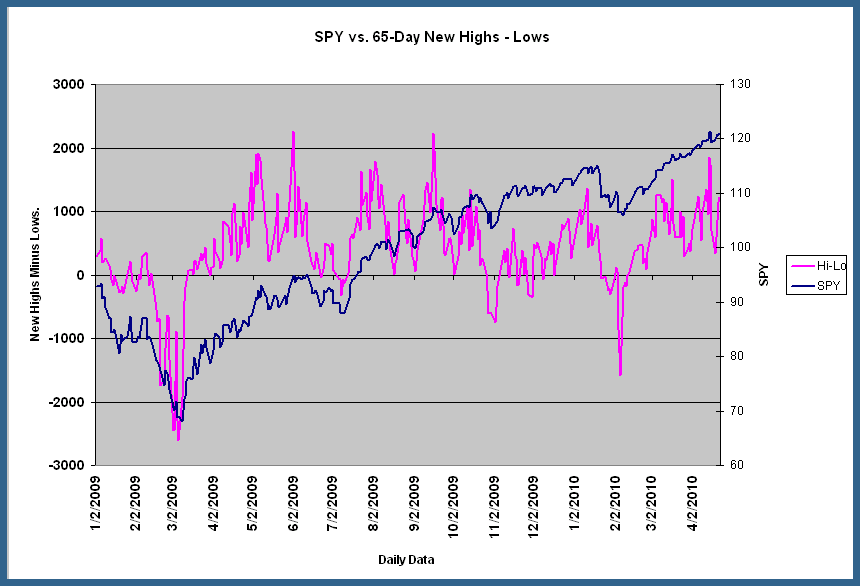TraderFeed An Introduction to Trading Stock Market Cycles Across Timeframes
Post on: 11 Апрель, 2015 No Comment

Saturday, September 20, 2008
An Introduction to Trading: Stock Market Cycles Across Timeframes
In this next installment of the Introduction to Trading e-book (see this link for all prior segments), we’ll examine examples of the aperiodic stock market cycles that form the first leg of our conceptual framework. Readers are strongly advised to read this prior portion of the book before going forward, so that they will understand the basic concepts behind cycle structure.
First let’s take a look at a long time frame (top chart). We made a momentum high in the Dow Jones Industrial Average (DJIA) in October, 1965 when we saw 160 stocks (out of the approximately 1400 that traded at that time) make fresh 52-week highs. That momentum high represented the point of maximum upside momentum from the long-term bull market that sprang from the momentum lows of the early 1930s all the way to the secondary lows of the late 1940s. From the momentum high in 1965, we made subsequent price highs in 1966, 1968, and 1972 before the market plunged to momentum lows in 1974 and eventual secondary lows in 1982. The entire sequence of a momentum high in 1966; secondary high in 1972; momentum low in 1974; and secondary low in 1982 represents a single cyclical structure.
Now let’s drill down a bit (bottom chart). From the Dow lows in March/April, 1980, we marched higher to a momentum high in November, 1980 and secondary highs in March, 1981. We then dropped to a momentum low in September, 1981 and secondary lows in March, June, and August, 1982. That sequence of a momentum high in November, 1980; secondary highs in March, 1981; momentum low in September, 1981; and secondary lows in summer, 1982 represents another cyclical structure—one nested within the cycle described in the earlier paragraph.
These are historical examples that I pulled from my database, using archived data for advancing vs. declining stocks and stocks making new 52-week highs and lows. Let’s take a look at several important implications of this cyclical structure:
1) The shape of a cycle is partly determined by the cyclical structures within which it is embedded. If we’re in a long-term downward phase of a cycle, the downward phase of an embedded shorter-term cycle will be exaggerated. During longer-term periods of topping and bottoming, we’ll see shorter-term cycles that are more symmetrical in the amplitude of their rises and declines.
2) There is a rough proportionality between the duration of the move from a momentum high to secondary price lows and the duration of the next bull market rise. Thus, we had a momentum peak in 1965 and a final, secondary low in 1982; that led us to an important long-term bull market momentum peak in 1999. Similarly, we hit a momentum peak in late 1980 and secondary lows in March-August, 1982; that led us to an important cyclical bull peak in early 1984. This rough proportionality, first laid out (to my knowledge) by Terry Laundry, is not precise to the day or week, but is a helpful guideline for broad investment timing.
3) One’s trading strategy should be adjusted for the phase of the market cycle being traded. As markets are gaining momentum, a trend-following strategy (buying dips in an uptrend; selling bounces in a downtrend) will be most successful. Once we have passed a momentum peak, countertrend trading (fading strength when buying dries up; fading weakness when selling dries up) will be most successful. Price alone is not sufficient as a basis for trading decisions: you have to know whether markets are gaining or losing participation as prices move to new highs or lows.

4) No cyclical structures are perfect. Secondary highs and lows are often fresh price highs and lows, but not always. Take the example of October, 1987—a dramatic momentum low on panic selling. That drop left a huge price tail intraday that was never taken out during the secondary price lows that occurred in 1988. Similarly, not all indexes will make fresh price highs at secondary highs: it’s precisely such divergences that help us identify secondary highs.
5) Note, too, that there can be multiple secondary highs or lows. As a rule, I’ve found that the longer the duration of the distribution process (the time between momentum highs (lows) and secondary highs (lows), the greater the trending move following the distribution. Some of the best bull markets, for example, have followed declines in which we had clearly defined secondary lows well spaced apart (see the lows of 1982, late 1990; late 1998); some of the best bear market have followed rises in which there was an extended period of topping (the highs of 1999-2001). In general, markets take longer to top than to bottom.
6) Different data are helpful in distinguishing momentum and secondary extremes for cycles at different time frames. Weekly data are helpful (advance/decline, new highs/lows, oscillators) for longer-term cycles; daily data for intermediate-term cycles; and intraday data for short-term cycles. I use very short-term data, such as NYSE TICK and Market Delta for short-term cyclical moves; end-of-day data to find divergences for intermediate-term moves.
It takes a fair amount of time studying short, intermediate, and long-term cycles to become sensitive to their variations and nestings. This is not a mystical numerical system and investors/traders who try to utilize this for precise timing will be disappointed. Rather, we’re constructing a conceptual system that tells us two things: 1) how the current time frame relates to the next larger one; and 2) how the market’s gaining and losing of strength and weakness is related to expectable price action going forward.
In my next post, we’ll take a few examples closer to our current time period.














